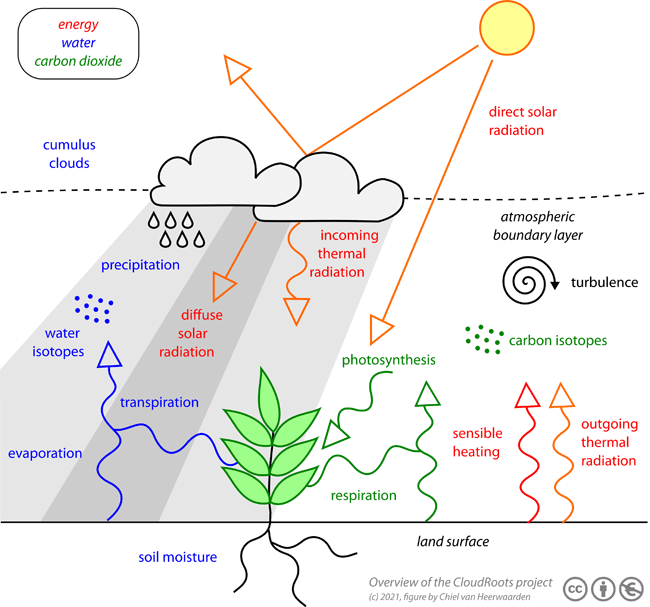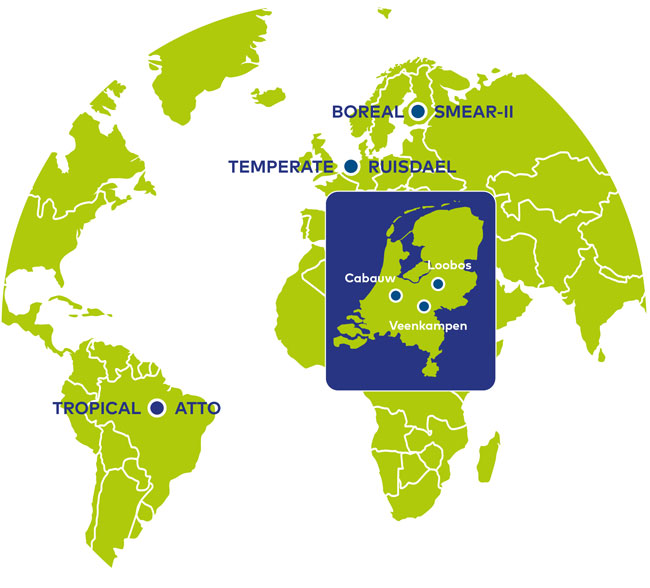Aspects of research
With recent summers in Europe characterized by heatwaves, droughts and extreme localized precipitation events, it has become evident that changes in climate and land-use have strongly influenced the magnitude and patterns of evapotranspiration, precipitation and cloud formation via feedbacks between the land and the atmosphere. Vegetation plays a critical role in modifying these dynamic interactions as it interlinks exchanges in energy, water and carbon.
SCALES
The diversity of mechanisms responsible for interactions between the (vegetated) land and the atmosphere range from the size of the stomata (10 – 100μm) to the size of the atmospheric boundary layer (~1 km). This includes temporal dynamics on time scales of minutes (passing clouds and plant responses), days (diurnal solar cycle) and seasons (seasonal solar cycle and vegetation dynamics) (TABLE).
Clouds as well as atmospheric-boundary layer dynamics disturb radiation and turbulence conditions in and above the vegetation canopy and, subsequently, the energy and moisture fluxes that affect clouds. Although these effects occur at short spatiotemporal scales, they have profound impacts on the regional and global CO2 budget. CloudRoots aims to advance current understanding of land-atmosphere dynamics. Therefore, it is essential to investigate, using first-principles, the cross-scale interactions between the relevant processes in an integrated observation – simulation system.

LEAF/PLANT
At the leaf level, CloudRoots will observe and attempt to mechanistically represent the exchange of carbon dioxide and water vapor through the stomatal aperture. One crucial aspect of this exchange is to understand to what degree plant stomatal control depends on the partitioning of direct and diffuse radiation perturbed by clouds (cloud flecks). We also need to understand to what extent the penetration of radiation into the canopy as well as temperature and vapor pressure deficit control photosynthesis. Photosynthesis and stomatal aperture are described by the leaf mechanistic model A-gs (A for photosynthesis and gs for the conductivity at leaf level, see figure below). This representation also includes the exchange of the light and heavy stable isotopologues of CO2 and H2O (CHEMISTRY). A-gs is used in the atmospheric models DALES and CLASS (see MODELLING). Soil evaporation and carbon dioxide respiration fluxes are represented by models that link soil properties to the in-canopy atmosphere. All these representations are supported by eco-physiological measurements (see ECOPHYS).
The CloudRoots representation of leaf, soil and cloud droplet CO2 and H2O exchanges

CANOPY/FIELD
CloudRoots focuses on how the available energy is partitioned on surface fluxes at the soil and by plants. Measuring the concentration and isofluxes of stable isotopologues of CO2, H2O enable us to quantify how much of the evaporation is driven by soil or by plants. Particular attention is paid on how to scale up the leaf processes to the canopy processes. To this end, the A-gs model (see LEAF) is upscaled to the canopy level. It is at the canopy level where the turbulent fluxes need to be accurately represented to adequately reproduce the dynamics of the clear and cloudy boundary-layers. In all the planned field campaigns, we attempt to measure these fluxes using eddy-covariance and scintillometer techniques (see INSTRUMENTS). With the later technique, we will measure 1-minute turbulent measurements of the carbon dioxide and water vapor stable isotopologues (isofluxes). Here, we expect to collect evidence on how the turbulent fluxes evolve under transition periods (clouds, diurnal and weather variability) and their partitioning. This research is connected to the explicit simulation of these turbulent fluxes. Here, we can make use of two sorts of canopy representations: multi-layer and bulk. Using the first approach, we can represent the transfer of radiation and the state meteorological and atmospheric composition variables within the canopy at the sub-meter scale. The bulk canopy approach enables us to determine the performance of more crude representations, like the ones used in weather and climate models, on the canopy turbulent fluxes.
LANDSCAPE
Moving up in the spatial scales, CloudRoots focuses on the landscape to study the effect of surface heterogeneity on the surface exchange fluxes and their impact on the boundary-layer dynamics. The landscape scale (the sub-kilometers scales) are still not well-resolved in weather and climate models. By measuring and simulating turbulent flux measurements of the carbon dioxide and water vapor stable isotopologues (isofluxes), we can determine how the turbulent fluxes change due to the contribution and aggregation of distinct fluxes controlled by different landscapes, and therefore, different partitioning properties. This will be further supported by simulating the isofluxes connected to the boundary-layer development using DALES and CLASS. Special attention will be paid to how grasslands and forests at the ecosystem level (see ECOSYSTEMS) react under different cloud, stress (drought) and heatwave conditions.
The CloudRoots representation of processes and their interactions at canopy, landscape and cloud scales

REGIONAL/GLOBAL
It is at the regional and global scales where we need to quantify how an improved description of the processes will yield better surface fluxes and improved descriptions of the interactions with clouds. Our hypothesis is that better representations of surface fluxes will lead a more accurate description of boundary-layer dynamics and clouds. To this end, our plan is to embed the large-eddy simulation to a high-resolution global model, ECMWF-IFS, and perform validations of surface and upper atmospheric conditions for multiple ecosystems over timescales ranging from one week to a full season.
DISCIPLINES
CloudRoots will develop an observation-simulation system with a specific focus on relationships between vegetation (BIOLOGY), the atmospheric composition and its transformation (CHEMISTRY) and the dynamics of clear and cloudy boundary layers (PHYSICS). Once this understanding is obtained, we will develop mathematical descriptions to represent these processes in weather and climate models. A key outcome of the CloudRoots findings is not only to study the present conditions of the land-atmosphere-cloud system, but also to investigate changes in plant and cloud behavior under future climate change conditions: enhanced CO2 levels, higher temperatures and an increase in the vapor pressure deficit.
The CloudRoots land-atmosphere-cloud system

PHYSICS
Physics is the third discipline investigated in CloudRoots. As the figure of DISCIPLINES shows, clouds perturb and control the amount of direct and diffuse radiation reaching the surface. The available energy is then partitioned into sensible heat flux, which is the main driver of atmospheric convective turbulence, and evapotranspiration, which is the main source of moisture needed to form and intensify clouds. Key aspects in this land-atmosphere-cloud system are the conditions in the free troposphere. These conditions are the lapse rate of temperature and moisture, and subsidence motions as well as the influence of large-scale advection. The combined and integrated experiments designed in CloudRoots will enable us to obtain enough observational evidence which will be used to design, constrain and evaluate the numerical experiments carried out by DALES and CLASS.
CHEMISTRY
Our main focus is to investigate the spatial evolution of the stable isotopes of carbon dioxide (12CO2, 13CO2 and C18OO) and water vapor (H216O, H218O). We plan to study whether the different fractionations between the heavy (13CO2 and C18OO, H218O) and light isotopologues (12CO2, H218O) provide a better quantification between soil, plant and atmospheric processes in the exchanges of water vapor and carbon dioxide under the presence of clouds.
In addition, we have the possibility to study the transformation of reactive species. More specifically, the chemical reactions associated with the NOx-O3-BVOC chain (NOx: nitrogen oxide, O3 ozone and BVOC biological volatile organic compounds) and the formation of secondary aerosol particles (SOC). These chemical mechanisms are incorporated into the two main modelling systems DALES and CLASS used in CloudRoots. These mechanisms offer the possibility to extend the study of the interactions in the land-atmosphere-cloud system to the formation of particles due to chemical transformations and how these transformations can influence the cloud microphysics and the subsequent cloud cycles.
BIOLOGY
As seen in the figure (FIGURE), the biological processes of leaves and soil are studied in CloudRoots. Driven by the amount of direct and diffuse radiation reaching the canopy, the leaves control the stomatal aperture and photosynthesis rate. We use mechanistic models to study the intermittency of light (sun or cloud flecks) and how they influence radiation, in-canopy temperature and water vapor deficit. Two photosynthesis pathways are included (C3/C4). A novel aspect of CloudRoots is to include the diurnal variability of water vapor and carbon dioxide stable isotopologues to study the individual contributions of soil and plants. The variability of soil moisture and temperature is also taken into account in representing the exchange of soil carbon dioxide (heterotrophic) and soil evaporation and their response to soil moisture stress (droughts).
ECOSYSTEMS
This novel multi-scale and multi-disciplinary approach will be applied and embedded in temperate ecosystems – grass (Cabauw, Veenkampen) and forest (Loobos)- at the Ruisdael observatory (Netherlands) as well as in a boreal forest (SMEAR-II, Finland) and a tropical rain forest (ATTO, Brazil) (see Figure). In all these ecosystems, clouds play a major role and therefore, we expect larger interactions between the ecosystems and the cloud organization. CloudRoots findings could be key to developing realistic and scalable model representations of the active role of the vegetated land in atmosphere dynamics, and vice versa, and will contribute to improving predictions of weather and climate.
The CloudRoots ecosystems: tropical, temperate and boreal, and their anchor stations

BOREAL-EUROPE
The boreal forest will complete the ecosystems understudy. Characterized by relatively moderate carbon storage and evaporative fraction, this system is also susceptible to potential changes due to more frequent droughts and heatwaves. We will make use of the smear-II observation station and use a modelling framework similar to the one proposed for the tropical and temperate ecosystems that will combine conceptual and explicit turbulent modelling.
TEMPERATE-EUROPE
The possibility of simultaneously studying the measurements taken at two grassland sites and a forest site in a temperate climate provides CloudRoots with the opportunity to relate the specifics of each ecosystem to similar cloud cycles. Special attention will be paid to the differences and relationships between water use efficiencies, evaporative fractions and cloud variables. In this ecosystem, we have the advantage of being an active partner of the Ruisdael observatory both in the collection of measurements (including the carbon and water vapor isotopologues and isofluxes) and the simulation in the DALES testbed of the three stations (see dashed line in the figure). This could provide an unprecedented level of detail for calculations and validation of the surface fluxes and cloud cycles, i.e., spatiotemporal scales of 100 meters and seconds.
TROPICAL-AMAZONIA
Characterized by strong carbon storage and strong evaporation rates, the rain forest in Amazonia is under increasing pressure due to extreme weather situations (drought, flooding) and deforestation. Our modelling and field experiments will be based around the ATTO tower. One of the main goals of CloudRoots is to determine how the partitioning of the surface fluxes controls the transition between shallow and deep convection during the wet and dry period, and in years influenced by el Niño or la Niña. Special emphasis will be placed on studying the relevance of local evaporation and moisture recycling compared to long-range sources of moisture. In the specific case of the rain forest, the height of the canopy (~30 meters) requires detailed profiles of observations and high vertical and horizontal resolution.